This was published 4 years ago
WestConnex: the toll road that ate Sydney
The hydra-headed 33-kilometre network of mostly tunnels that burrows towards the city from the south and west has been a signature project of the Coalition’s decade in power.
By Deborah Snow and Matt O'Sullivan
At a university event six years ago, the then chief executive of the Committee for Sydney, Dr Tim Williams, a man with impeccable urban planning credentials, questioned why the state government was planning a major new inner-city motorway while other global cities were intent on removing theirs.
The project he had in his sights was WestConnex. The response from then roads minister, Duncan Gay, was immediate. Gay complained angrily to the committee’s board and described Williams in Parliament as a “rogue operator” who should no longer be in the job.
Williams says he has worn Gay’s description of him as a “badge of pride” ever since. “I have never resiled from my views,” Williams tells The Sydney Morning Herald. “We have a sprawling city which roads like this make even more sprawling; it’s an incoherent project that has actually destroyed value and damaged places and is in danger of pouring cars into the wrong places.”
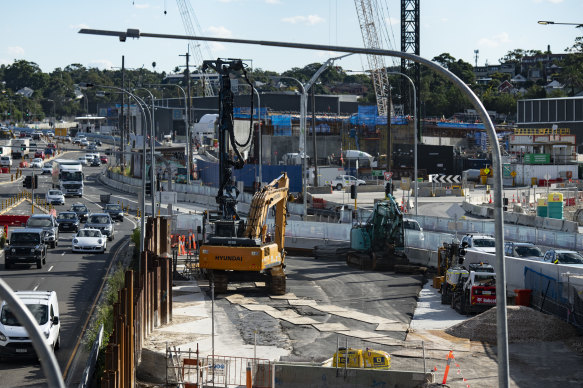
Construction of the interchange for WestConnex at Rozelle.Credit: Wolter Peeters
Gay’s irate reaction was a telling demonstration of the project’s political sensitivity. More than any other piece of state infrastructure, WestConnex has been a signature project of the Coalition’s decade in power since Barry O’Farrell swept into office on March 26, 2011.
The hydra-headed 33-kilometre network of mostly tunnels burrows towards the city from the south and west. It incorporates the widened M4 from Parramatta to Homebush; the M4 East tunnel from Homebush to Haberfield; the existing M5 East from Beverly Hills to the airport; the recently opened M8 which duplicates the M5 tunnels; a tunnelled link between the M4 and the M5; and the planned underground multi-level interchange at Rozelle, where construction activity near the Anzac Bridge has rendered the urban landscape a vast swathe of machinery and earthworks.
The project’s sheer momentum is set to expand Sydney’s sprawling tolled motorway network even further: to the north via a second road tunnel under the harbour, and to the south from Arncliffe by way of the new M6.
Williams labels this “massive mission creep”, arguing that the major design changes to WestConnex over time reflect “an ever elusive attempt to find the benefits to justify it”.
But the state government says WestConnex is vital to unclogging critical parts of the city’s road arteries.
Transport Minister Andrew Constance insists the benefits of “the largest motorway project in the nation’s history” are already being seen in the “improved ease with which people are able to disperse across the existing road network”.
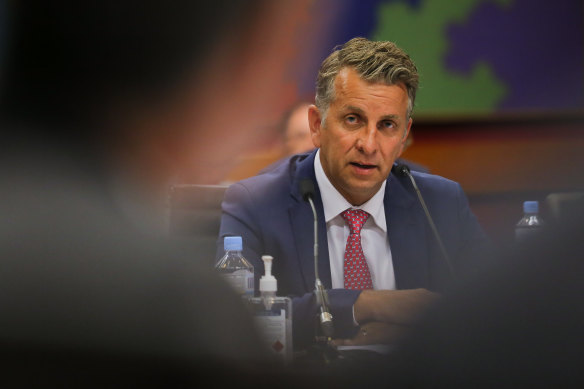
Transport and Roads Minister Andrew Constance says the benefits of WestConnex are already evident.Credit: Steven Saphore
Congestion, he says, was going to cost the state $6 billion a year. “If we didn’t have the toll roads imagine what the rest of the network would look like? It wouldn’t work,” he says.
There’s an even more enthusiastic pitch from WestConnex chief and long-time Transurban executive Andrew Head, who describes the mammoth project as part of a “comprehensive mobility package” needed to allow Sydney to reach its “full potential” as a global city.
“We’re thinking big,” he tells the Herald. “Sydney won’t realise its potential if it’s only the motorways, or only rail or only on foot ... It’s got to be a combination.”
Gay, the former roads minister who oversaw WestConnex, says ultimately there “are a lot of people who have to travel by car”.
“It is not feasible to back heavy rail into every Coles and Aldi. We have to have a mix of transport,” he says.
Yet Williams is far from alone in challenging the notion that putting major new motorways through cities is the modern-day answer to congestion. Critics point to the phenomenon of “induced demand”, where major new roads entice more people into cars and ultimately shift bottlenecks to new points along the road network.
Professor James Weirick, an eminent urbanist at the University of NSW, labels WestConnex an “indefensible proposition”.
“To have induced demand converging on the centre of the city has been proven wrong in every major city in the world,” he argues.
Professor Peter Newman of Curtin University, a former NSW Sustainability commissioner and one-time board member of the federal government’s advisory body, Infrastructure Australia, says “it’s an old paradigm of how you make cities which was discredited by the end of last century - this road has spun out into a massive underground set of tentacles that are slowly killing the city.”
The financial engineering that has gone into the WestConnex deal has also garnered controversy.
In 2014, the government set up a private company called the Sydney Motorway Corporation (SMC) to manage the financing of WestConnex. Four years later it sold a 51 per cent stake in SMC to a consortium dominated by toll road giant Transurban.
The consortium paid $9.26 billion, in return for which the private operators will collect tolls across the WestConnex motorways for the next 40 years. The government now plans to sell off the remaining 49 per cent, in two tranches, a move which could put WestConnex entirely in the hands of Transurban and its partners.
Transferring the project into the SMC had several pluses for the state government. By parking the multibillion-dollar project inside a corporate vehicle it shuffled WestConnex off the government’s books and prevented it weighing on the state’s treasured credit rating.
Because SMC is a private company it reduced its exposure to freedom of information requests and budget estimates hearings. And it has markedly reduced the ability of the state Auditor-General to keep the project under scrutiny.
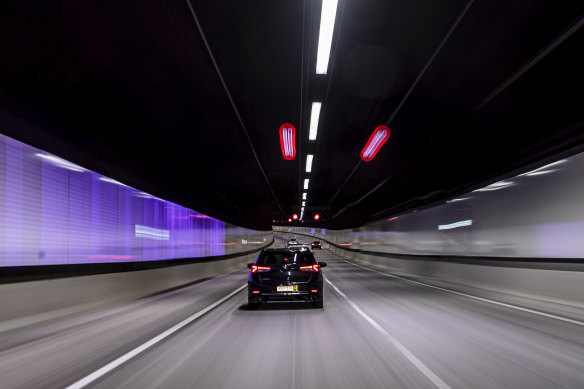
The M8 tunnel (duplicating the M5 East) opened to motorists last July as part of the second stage of WestConnex.Credit: Brook Mitchell
Unlike the Victorian and Commonwealth governments, the NSW Auditor-General does not have so-called “follow the dollar” powers which would allow it to track the project once it disappears behind the corporate veil.
In addition, WestConnex’s deep financial underpinnings - what the state Treasury calls the “base case financial model” - are to remain secret until 2060. That is longer than most cabinet papers.
Tony Harris, a former state auditor-general, recalls how he had tried and failed to get such “follow the dollar’ powers when he held the job in the 1990s. He is scathing about the staggering length of the confidentiality arrangements, saying “if you deal with government you have to have a disclosure environment”.
In December 2018, a NSW Legislative Council committee looking at WestConnex urged that in future all “base-case financial models” for infrastructure projects be made public 18 months after commencement.
Constance however defends the way the deal was set up, arguing it has let the Coalition “grow the farm”.
“We’ve created these new assets and are recycling them to build more infrastructure,” he says, adding that the base financial case has to remain secret for “commercial in confidence” reasons.
WestConnex’s deep financial underpinnings are to remain secret until 2060. That is longer than most cabinet papers.
Andrew Head, the WestConnex chief, initially told the Herald that the 40-year secrecy arrangements were a matter for government. However, he defended them on the basis that “companies that invested in it, including Transurban, are listed companies, and providing long-term forecasts is not something that is advisable because people buy and sell shares on a daily basis, and there are continuous disclosure obligations”.
“To provide a forecast between now and 2060 would be almost unheard of,” he maintains.
Human toll
Often forgotten in the big-picture talk is the plight of inner-city communities – and the individuals living within them - which have borne the impact of the project’s relentless march.
Richard Capuano was one of those forced out of his terrace house in St Peters in late 2016. His home of 18 years was bulldozed months later to make way for WestConnex.
More than four years on, he’s despondent about the government’s compulsory acquisition process and his treatment. “The stress, the PTSD, the displacement is just horrible. I still have bad dreams about it,” he says. “There are hundreds of people who are still hurting.”
After a two-year legal battle in the Land and Environment Court he received $1 million for his house. But the legal fight cost him $300,000, and he was unable to buy back into Sydney. He now lives in the lower Hunter.
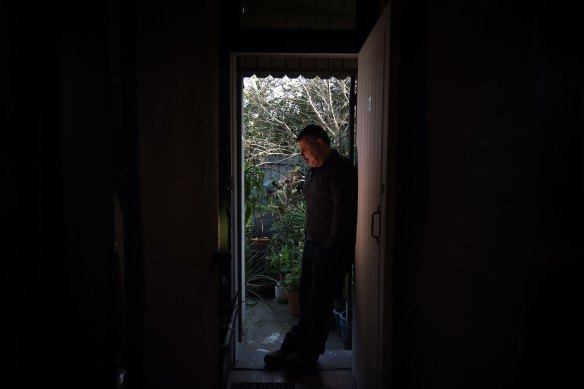
Richard Capuano says the forced acquisition of his St Peters home for WestConnex has left him ‘utterly damaged’.Credit: Kate Geraghty
“I am at a point in my life when it’s really hard to start again. It’s completely and utterly damaged me,” the 52-year-old says.
These kinds of upheavals are not factored into the cost-benefit ratios of the project, which the government insists is still within its overall construction budget of $16.8 billion - a figure, incidentally, it has not updated since late 2015.
NSW Labor is growing increasingly vocal about the impact of the tolling regime on some of the city’s poorest residents.
WestConnex is allowed to raise tolls by at least 4 per cent each year for the next two decades, and then by the rate of inflation for the 20 years beyond that.
Given annual inflation is at 0.9 per cent, it’s turned into an excellent deal for the WestConnex partners – particularly when tolls on other motorways only rise at the rate of inflation.
Labor’s road spokesman, John Graham, says 15 toll roads will ring Sydney in “just a couple of years, and they are wildly unequal depending on where you live”.
He highlights recent analysis from consulting firm Alpha Beta, which showed the highest 10 per cent of toll-paying households in Fairfield, in the outer west, were spending an average of $6046 a year.
At the same time, he says, trucks and cars have flooded back onto local roads in Bexley since the government reimposed a toll on the M5 East last July, after it was officially folded into the second stage of WestConnex.
“They made the public case that they would get cars and trucks off suburban streets,” Graham says. “What’s the result? Gold-plated tunnels and motorways and ordinary drivers forced onto suburban streets - that is the Sydney that we are creating.”
In response, Constance points to the government’s toll relief package, which allows motorists to get a refund on their car registration costs, after spending an average of $26 a week on tolls. He says his advice from Transport is that “60 per cent of motorists pay less than $10 a week in tolls”.
Transurban says its Linkt data from the year before COVID-19 hit (February 2019 to January 2020) shows only 0.43 per cent of its Sydney customers spent more than $100 a week, while 80 per cent spent less than $10 a week. The distance-based tolls across the WestConnex network are also capped per journey.
But Graham says “just getting $400 off your rego does not deal with the scale of the problem”.
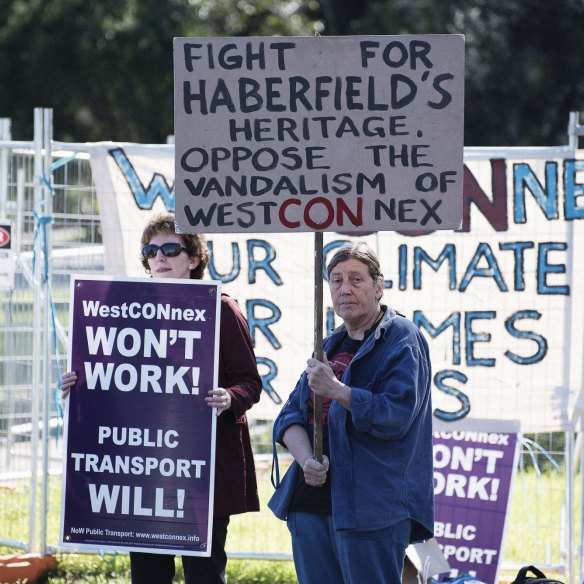
Protesters in Haberfield in 2016. Inner-city communities have borne the impact of the project.Credit: Christopher Pearce
Analysts worry that the 40-year WestConnex tolling agreement ties the hands of future governments which might want to try new approaches in regulating the use of the motorways.
“It introduces rigidity,” explains Martin Locke, a former PwC partner now an adjunct professor at the University of Sydney Business School.
“There is a high degree of likelihood that policymakers might want to change tolling strategies, for instance, how to introduce time of congestion pricing, or time of day pricing,” he says. But with the lengthy concessions to dominant operator Transurban, “the government has effectively given away the policy control levers”.
Transurban’s group executive for NSW, Michele Huey, says the company is “open and willing” to discussions about modernising the tolling arrangements. But “for this to happen our investors can be no worse off”.
Veering off course
One aspect of the project that has most incensed critics is its morphing over time, well beyond its original aims.
WestConnex had its genesis in the earliest days of the O’Farrell government, which set up a new body called Infrastructure NSW and put former Liberal premier Nick Greiner, often regarded as the grandfather of Sydney’s toll road network, in charge. It also won enthusiastic backing from Tony Abbott at the federal level.
There was thus immense political momentum behind it.
In the beginning, the promise was the project would take traffic off Parramatta Road, relieve pressure on the M4 and M5, and fill in a “missing link” to Kingsford Smith Airport and Port Botany. The original design did not veer towards the city via the Anzac Bridge.
But by 2014, the government was flagging an Anzac Bridge connection into the CBD and a link to a Western Harbour Tunnel, both of which envisaged a major underground interchange at Rozelle.
“The reason it got dragged towards the city is because that’s where the traffic wants to go and you can charge CBD workers high rates to use the toll road,” says one analyst, who wants to remain anonymous.
The port had dropped out of the project early on, and by 2017 the government had also taken out of WestConnex a planned new link to the airport known as Sydney Gateway, claiming the connection was now so “strategically significant” it had to be considered a project of its own.
In a revealing comment, Greiner told the Herald in 2018 WestConnex was “meant to fix Parramatta Road - it has veered from its original purpose”, before adding, “but I really don’t want to go there”.
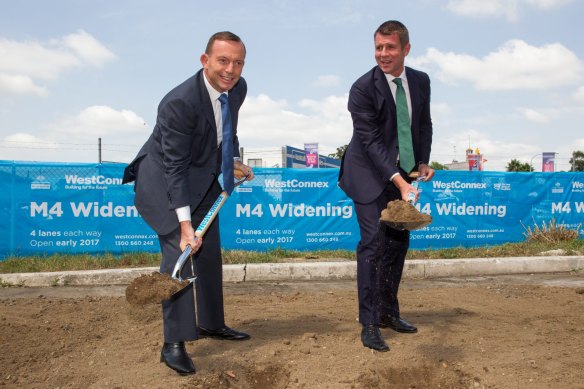
Digging in: Prime Minister Tony Abbott and NSW Premier Mike Baird at a WestConnex press call in 2015.Credit: Edwina Pickles
Nearly 10 years on, the state government has still not fulfilled its undertaking to improve urban amenity along Parramatta Road, though Transurban says traffic along it has reduced by “almost a third” since the M4 tunnels opened.
Constance defends the shape shifting, saying increased confidence about patronage meant the government “changed its aspirations around what it could do as the project was built”.
But others argue it’s at least in part a result of the business case never having been thoroughly thought out in the first place.
Labor transport spokesman Chris Minns believes the M6 extension in Sydney’s south “is more about traffic flow to [WestConnex to] make finances of the project stack up rather than anything else. It seems every time they complete a section, it creates a problem somewhere else.”
Some analysts see the network having to grow to feed itself enough traffic volume to justify the cost.
Dr Geoffrey Clinton from Sydney University’s Institute of Transport and Logistics Studies says with any major road-building project, there is a “risk of chasing your tail, you end up having to build a road to alleviate the choke point that was created by the last road project”.
Overall costs have become harder to calculate over time. By no longer including the airport link as part of the project, the government effectively removes up to $1.8 billion from the headline cost.
Likewise, the Western Harbour Tunnel is not included in cost calculations, nor is the M6 extension, even though both will benefit WestConnex by drawing in more traffic.
‘This road has spun out into a massive underground set of tentacles that are slowly killing the city.’
Professor Peter Newman
Town planning expert Dr Glen Searle told the 2018 parliamentary inquiry into the impacts of WestConnex that “one of the key omissions in the business case is the cost of upgrading connecting roads” to the motorway.
Williams says the “original sin” is the failure to have fully assessed plans in place before the project was announced - an omission conceded by senior bureaucrats who appeared before the parliamentary inquiry.
The inquiry’s final report found the government had “failed to adequately consider” alternative options at the start of the project.
However, WestConnex chief Andrew Head insists more people will see the benefits as the project is completed, with travel times already “slashed” on the M5 East and motorists saving up to 30 minutes between Liverpool and the CBD during morning and evening peaks.
Head says surveys commissioned by WestConnex show positive sentiment towards the project has climbed in the past two years, with “people telling us … that the travel time savings are great, that local streets are improving” and they can see amenities like cycleways and parks being given a place.
Constance also remains an unabashed champion. “We haven’t realised its full potential yet … anyone driving in from Wollongong knows the frustration of driving through the Sutherland Shire; anyone stuck on the Anzac Bridge and the Harbour Bridge knows that by having the Western Harbour Tunnel, you are going to be able to alleviate the pressure there.”
But Tim Williams remains unconvinced, saying “it always lacked a real justification”.
“In future the public needs to be informed of the thinking of governments as to what problems they see as essential to solve and why this and only this mode is the answer.”
Start your day informed
Our Morning Edition newsletter is a curated guide to the most important and interesting stories, analysis and insights. Sign up here.